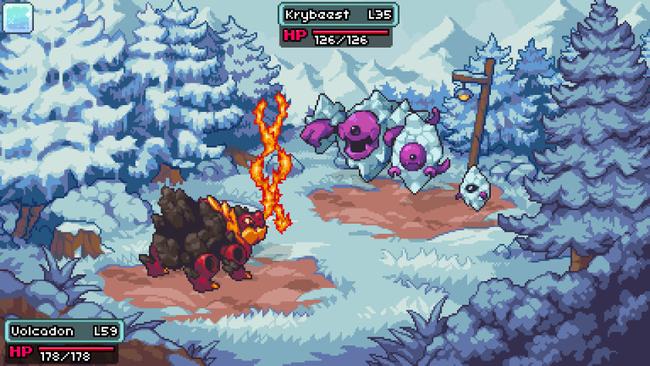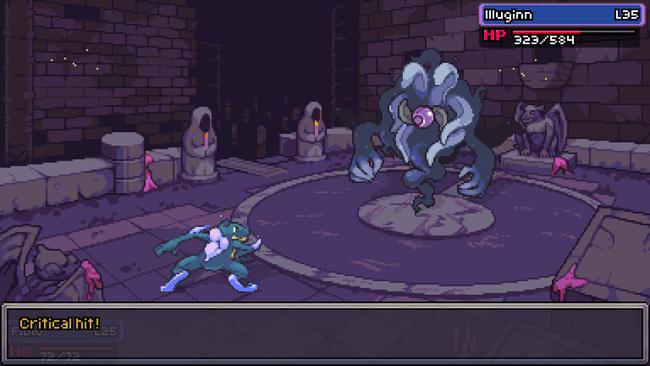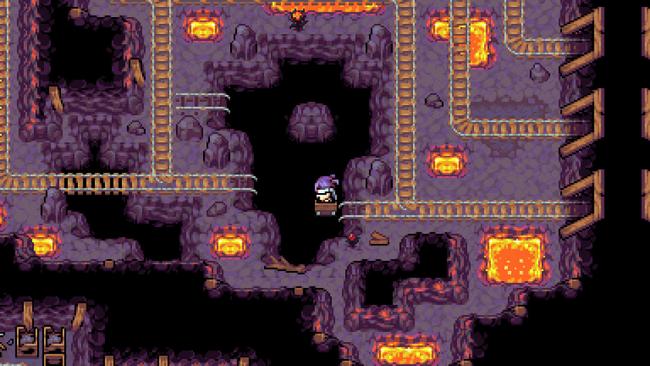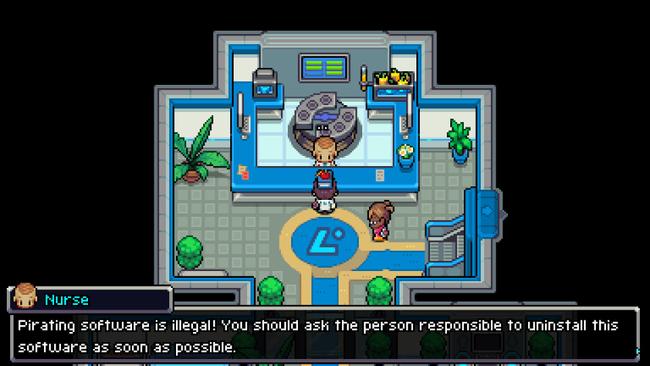Coromon Review
Coromon is a game that easily fits into the monster-tamer genre. That is, the primary gameplay involves catching and usually battling various creatures. Oftentimes, no matter how different they are, these sorts of games will be compared to Pokemon. In Coromon’s case, however, it is deliberately Poke-like. From training a team of up to six and competing in turn-based battles with a four-move pool, to the similar progress structure, it would be a disservice not to mention the comparison.
In this part of the world, those who catch and battle with Coromon are all researchers working for the Lux Solis corporation. As a promising new recruit, you’ve been tasked with collecting titan essence from the titans that live in the Velua region. These titans are imposing elemental-based creatures that work in harmony with the land around them, and you’ll have to prove yourself in battle to get their essence. But before that, however, you’ll need to reach the areas via different routes, solve the locals’ problems, and then find the titan by going through a dungeon-like area. During your journey, you’ll engage in turn-based battles, catch Coromon, and evolve them.

These turn-based battles come with most everything you’d expect from a Poke-like. Coromon can only have four moves equipped at any time, but outside of battle you can conveniently switch what punches they’re packing from their learned move pool. A singular set of Skill Points are used for all moves, and you can heal half of them in battle by taking a turn to rest. HP and SP can be replenished with various kinds of cakes, though I was constantly broke throughout the game as I was often using items to heal from heavy-hitting attacks.
Held items are also very important, and I frequently used the Lazy Gem, which is basically an EXP Share but tied to the individual mon on the receiving end. There are also fruits that can be planted to be harvested later, and there are a LOT of them. Certain fruits will automatically replenish HP or SP while others can increase EXP gained or instantly charge a two-turn attack. Other useful items are Skill Flashes, which can teach specific moves, or the scents which may increase your chances of running to Coromon with a pre-inflicted status effect, though I rarely used them. Extra items can be given out as promotion bonuses, which are gained by achieving (often repeatable) achievements.
The typical status effects are present and can be induced by weather conditions. Status effects do gradually wear off over time, and thankfully poison damage does not continue with each step you take. Coromon can also have inherent passive abilities such as toxic skin or static fur, which will inflict an opponent with a status effect if they make physical contact. I also liked ones like Conductor, when my electric-type Lumasect‘s speed would increase every time they got hit with an electrical attack. Annoyingly, if a move involves multiple hits, these effects will be updated in the dialogue box text every time, which slows things down. If the final opponent is beaten, any effects, buffs or debuffs still take their time to apply, which is minorly irritating. As a change of pace, Coromon can also evolve between fights in a battle, meaning during a mirror match having destroyed his counterpart my starter monster evolved making it a not-so-even fight after all.

When it comes to catching Coromon, you can come across several colour variants of each monster. These aren’t as rare as shinies in Pokemon but actually tie into the potency system. Asides from the regular level-ups, there is a separate progress bar that when filled allows you to add three points to any battle stat of your choosing. A Coromon with more potential has more opportunities to apply these stat-ups before maxing out. There are standard, potent & perfect Coromon, and tying it into an actual useful gameplay system makes the hunt for catching one much more fun. I was, however, able to get through the whole story only using one potent monster. If you ever feel like you’ve messed with your stats in the wrong way, you can eventually use money to increase their potential or reset it, allowing you to reattribute the stats. This is probably the only point in the game in which money is a clear issue.
Something I didn’t exactly pick up on until later in the game is that all the Coromon have only one typing, so there are no fire-ghosts to be found. Part of this is perhaps due to the small pool of there being seven types that a Coromon can have, and then six types that are only found in skills. This meant that having type-effective mons was extremely necessary if I wanted to avoid constant fainting during my playthrough. Towards the end, you’ll encounter Coromon influenced with a type that is resistant to all, making them particularly bothersome to fight.
The gameplay is shaken up a bit by the various non-battling tasks you’ll need to complete to progress, whether it’s finding lost souls or stealth segments. Even making it to another town might involve tasks like avoiding the sun or collecting mushrooms. Thankfully, the developers have increased the checkpoints since the Early Access period, so most players should be able to get through them. I found myself both refreshed and sometimes irritated by these moments.
Within the dungeons themselves, there are puzzles ranging from a game of mastermind to basic ice sliding. After the halfway point, these challenges seemed to get easier (which after the ones in the desert temple, I didn’t really mind). To navigate throughout the game you’ll make use of your gauntlet, which will be equipped with various modules as you progress. Enabling you to light objects on fire, push heavy logs and so on without needing to enlist your Coromon for the task.

While I was promised the titan fights would have multiple phases and be pretty challenging, I found having at least one type-effective mon close to the same level was enough to get me by. In fact, I found the game seemed to get easier the further I got (with one exception).
This was playing on the normal difficulty, but there is an easier option or inbuilt nuzlocke difficulties too. On hard, fainted Coromon will be permanently released and you cannot escape from any battles. For the complete experience, you can remove the use of escape items and restrict catching to only one Coromon per area. Later on you can customise the difficulty settings to make things easier, more difficult, or randomized.

The story starts out intriguing, but it all turns out to be rather basic and ends quite flatly, which the developers even plan to change in the future. You’re also tossed into the world with next to no post-game, unless you count the developer fight (mostly a gold and exp grind), which after beating the game is a cakewalk.
When comparing it directly to Pokemon, I like that TRAGsoft decided to make their own game in a unique world. Instead of relying on gyms, they made dungeons and titan battles. However the "bad guy team" replacement had very minimal presence in the game. The comparison of Coromon to Pokemon also becomes unfavourable when we compare the lack of side activities. For one there's no breeding, which as a fan of is a bit disappointing but not every such game has it. When it comes to any mini-games or non-battle activities to do with your Coromon, there is practically nothing, assuming you did all the side quests in your playthrough. There is gem and treasure hunting, but neither of which I would call fun. Of course, there is online play where you can use your own team or a randomised maxed-out loan party. With options for casual, custom, and ranked matches and this is likely where any more playtime will take place.
I largely adore the pixel art style of the game, but playing at full screen makes the art appear majorly stretched out, which is sad. Coromon is a very colorful game with detailed battle backgrounds and some really gorgeous animations on some of the monsters. In particular, the moves that formed a wall and pushed your mon out of battle were funny to witness. The lack of an option to skip animations is a bit perplexing, though.

I found the variety in monster design wasn’t so bad overall, though there were a few too many blob-like creatures. I am also very sad that I knocked out the Skuldra that some children had drawn a face on top of. Meanwhile I never became accustomed to the human sprites, largely as their heads felt entirely too big even with the cool hats I can collect. As a way for the human characters to express emotions, emoticon-like animations would pop up and I felt they were a bit too childish and unnecessary. The music definitely wears its flavour of influence, especially the trainer battle music. Still, it is good enough to be enjoyed outside of the game, especially the titan battle track.
Coromon is a game filled with potential but past sinking sands and perplexing puzzles it starts to fall flat. Fans of the genre will be delighted by the levels of customization thanks to the potential system and easy skill switching. Though, once you beat the roughly twenty-three or so hour campaign you'll find little to do. While some elements are stated to be getting worked on, two months after release, the game is still the same. Hopefully those who are waiting on the delayed Switch and mobile release will get them at the same time as any major updates to the game. For the PC and budget gamer, however, this is still a fine choice, and there is an accessible demo letting you play the start of the game. The shake-ups do let Coromon stand on its own and create an enjoyable experience, but it could’ve evolved to be something a little more.